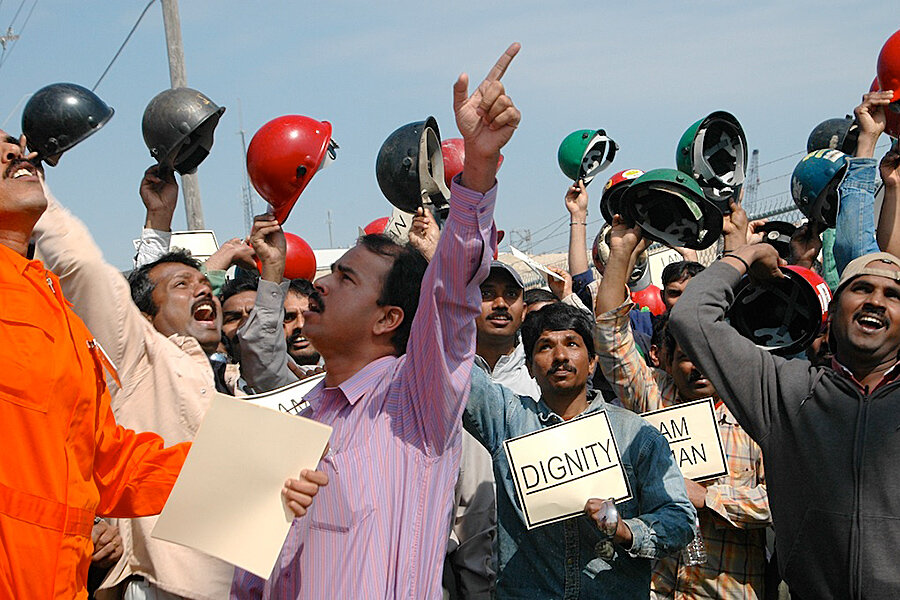An epic legal battle pays off for trafficked workers
Loading...
This story was designed to be read on the Monitor's long-form platform. Click here for that version.
In 2006, with the US Gulf Coast still struggling to recover from Hurricane Katrina, about 590 Indian men arrived in Pascagoula, Miss. and Orange, Texas to work for Signal International.
The men were welders and pipefitters, and other experts in marine fabrication. They knew that the work with Signal, a maritime construction company that was a regular subcontractor for Northrop Grumman Corp., would be hard and dangerous. They would be repairing oilrigs and other offshore oil and gas facilities damaged by the hurricane.
Crucially, they believed that this US job was so attractive that they were prepared to mortgage their homes and sell off gems and jewelry to come up with the $11,000-to-$25,000 that the company’s recruiters charged for fees, immigration processing – all received H-2B guest-worker visas – and travel to the Gulf Coast. After all, they would later explain, they were promised that the Signal job would lead to permanent residency for themselves and their families in the US.
Instead, the Indian workers said they found crammed and isolated labor camps, abusive employers, hefty fees that made their take-home pay minimal, and faced the constant threat of deportation and even physical harm – both to themselves and to their loved ones back home. In short, they became victims of labor trafficking in a way that many human rights advocates say is shockingly common across the US.
But there is something unique about the case of the Indian men working for Signal International: They went to court. And they won.
The case is, in many ways, a model for how to fight labor trafficking – both in the courtroom and out. But if it shows the potential of litigation to sting traffickers and deter future abuses, it also shows the huge challenges and drawbacks of a purely legal response to modern-day slavery. Even as the Indian workers won their victory in civil court, the criminal case against Signal and its representatives fizzled – a sign that shows how far the legal system is failing to deliver justice to those caught in the traffickers’ clutches.
"Complex labor trafficking prosecutions are very difficult, they’re very resource intense. And we’re not seeing law enforcement take enough of these on,” says Dan Werner, a lawyer for the Southern Poverty Law Center. “It’s a lot easier to raid brothels [for sex trafficking].”
A trafficking lawsuit triggers a bankruptcy
In February of this year, a federal court in New Orleans awarded five Indian workers $14 million in a labor trafficking lawsuit against Signal, which is based in Mobile, Ala. The court also found liable an immigration lawyer named Malvern Burnett, who plaintiffs said facilitated the scheme, and Sachin Dewan, an Indian labor recruiter. Both have appealed the verdict. Mr. Dewan is in India, which limits the court’s ability to enforce the judgment.
Five months later, Signal filed for Chapter 11 bankruptcy protection to implement a $20 million settlement with more than 200 other workers who had their own lawsuits pending. It was, lawyers say, the largest monetary penalty ever in a labor trafficking lawsuit.
But to get there, those familiar with the case say, it took an atypically mobilized group of workers, observant and concerned community members, engaged advocacy groups and, ultimately, an unprecedented collaboration between the Montgomery, Ala.-based Southern Poverty Law Center (SLPC) and other for-profit law firms across the country.
“It took years,” says Neha Misra, senior specialist for migration and human trafficking with Solidarity Center. “And a lot of money.”
First steps to freedom
Back in 2006, the Indian workers realized their situation at Signal International was not at all what they had been promised. So they began talking with one another, both in the crammed trailers where they were forced to live, and also at the local Catholic Church, where some of the men went for services. Soon, the church pastor connected the men with a local worker rights group.
“We started meeting with them,” recalls Jacob Horwitz of the National Guestworker Alliance, an advocacy group for migrant workers. “The workers began organizing around very basic things.”
For starters, they wanted to improve their squalid living situations, which among other things had 24 men on different shifts all crammed into double wide trailers, so they woke each other regularly. They were exhausted – a safety risk for those working on oilrigs. They wanted better food, which even company officials acknowledged in internal documents was terrible and often unsanitary, and cleaner mess halls.
The advocates connected the men with the SPLC, which sent a letter to Signal asking to sit down with managers and talk about the workers’ concerns.
Advocates say that “first responder” recognition of evident exploitation – awareness on the part of health workers, pastors and other community members – is key to fighting labor trafficking. Workers who are organized are also much less likely to be trafficked, advocates say.
But as what happened next showed, mobilization can be risky for trafficked workers at the mercy of abusive employers.
Sanctioned reprisals
The reaction by Signal, according to court documents, was swift and furious. In the pre-daylight hours of March 9, 2007, armed guards raided the camps where the Indians lived and forced those suspected of organizing the workers into a locked trailer. Signal managers told the men they were going to be deported – a huge threat for workers who had taken out crushing debts back home. One of the workers was so distraught he attempted suicide.
The four men locked in the trailer were not deported. But this was only because the rest of the workers went on strike, Mr. Horwitz says.
“We were successful at getting those men released and we were able to get immigration protections to those four,” he says. “After that it was really hard to reach workers. They were terrified…. It took us nearly a year to rebuild the trust among workers and empower them enough that they were ready to walk out of camp and report their company.”
The intimidation, according to internal company documents, was intentional. It was also, according to court testimony, a policy that two Signal officials said was sanctioned by Immigration and Customs Enforcement agents.
“The next time some disgruntled employee barks, they’ll think twice about wasting their time again,” read one e-mail. “Before the weekend is over, the Indians will know we’re not afraid to fight and so should their liberal lawyers.”
Not long after the 2007 roundup, lawyers at the SPLC filed a lawsuit with seven named plaintiffs on behalf of all of Signal International’s hundreds of H2-B guest workers. But at that stage they had no idea how the case would snowball.
They would receive 2.5 million documents from Signal in discovery. There would be hundreds of hours of deposition. Signal – whose largest investor was the Retirement Systems of Alabama, a public pension fund – would fight every legal battle, insisting it had done nothing wrong. And the SPLC would lose its effort to certify the Indian workers as a class, which meant that instead of one lawsuit, there would have to be many.
It was, in short, a colossal undertaking. And the plaintiffs were transient, guest workers who might leave the country at any time. They were in debt to labor recruiters – and worried about the consequences for family members back home.
“I’ve never litigated a case like this that’s involved so many hours or so many years of pretty constant work,” says Mr. Werner, the supervising attorney for the SPLC’s immigrant justice initiative.
'Kind of amazing'
Indeed, there is no way that the SPLC could have done it alone. But it had help – pro-bono assistance from some of the top law firms in the country, who each agreed to represent some of the Indian plaintiffs. It was a legal collaboration on a case that many advocates call unprecedented for such a pro bono initiative.
“It’s kind of amazing, right?” Werner says. “I don’t know if anything like this has ever happened before. We just went out and talked about the case.”
Werner says that he believes law firms would step up again if faced with the opportunity to take on another trafficking case. But it is hard to scale up this sort of collaboration because of the sheer volume of work involved. The US has robust laws, including racketeering and fraud statutes, under which plaintiffs can seek damages in trafficking cases. Still, it takes a gigantic amount of manpower to use them to the fullest extent.
The legal battle was only one front of the Signal case. As the Southern Poverty Law Center dove into its work, the Indian men themselves were mobilizing to demand a response from officials in Washington and New Delhi.
A year after the March 2007 raid, a group of 100 Signal employees quit their jobs, risking deportation under their immigration status. They began a march from Mississippi to Washington DC, saying they were following in the footsteps of both Mohandas Gandhi and Dr. Martin Luther King Jr. When they did not get support from either the Indian embassy of the UN High Commissioner for Human Rights, they began a hunger strike. About a month later, Rep. Jim McDermott, a prominent voice on US-India affairs, told them he would try to support their cause.
Soon thereafter, the Equal Employment Opportunity Commission filed a suit against Signal, saying that the company was discriminatory against its guest workers. The Department of Justice also said it would begin an investigation.
But that criminal case didn’t get traction – a pattern that Werner and others say is common for labor trafficking investigations.
While experts say that civil cases like the one against Signal does send a message to other companies, many advocates would like to see more criminal prosecutions. A 2014 Urban Institute and Northeastern University study on labor trafficking found myriad barriers to effective policing, which range from a lack of awareness on the part of law enforcement to challenges in getting corroborating evidence. Researchers also found that law enforcement agencies were reluctant to pursue immigration relief for alleged victims. And as the Signal cases show, investigating alleged wrongdoing is an intensive slog.
Today, almost a decade after they arrived to the US, the 232 plaintiffs in the Signal lawsuits, many working in other jobs in the US, are waiting to receive money from the court judgment as the company goes through bankruptcy proceedings.











